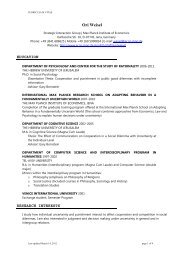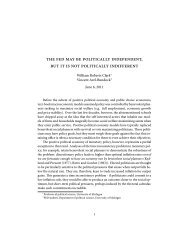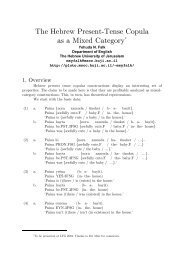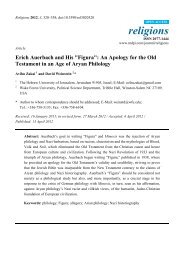Transitive verbs with non-accusative alternation in ... - Pluto Huji Ac Il
Transitive verbs with non-accusative alternation in ... - Pluto Huji Ac Il
Transitive verbs with non-accusative alternation in ... - Pluto Huji Ac Il
Create successful ePaper yourself
Turn your PDF publications into a flip-book with our unique Google optimized e-Paper software.
78<br />
Rivka Halevy<br />
3.3.1. Instantiation vs. genericity<br />
From a logico-semantic po<strong>in</strong>t of view, every situation is unique and<br />
unrepeatable. Therefore no sharp dist<strong>in</strong>ction can be drawn between the<br />
<strong>in</strong>dividual and the generic level. However, if we adopt a less <strong>in</strong>clusive view<br />
of the notions of <strong>in</strong>dividuality and actuality, we may differentiate between<br />
<strong>in</strong>dividually <strong>in</strong>stantiated events and generically conceived ones.<br />
Just like there can be assumed to be a correlation between <strong>in</strong>dividuation,<br />
i.e. specific <strong>in</strong>stantiation, and imperfectivity, I shall suggest that there is<br />
also a correlation between <strong>in</strong>dividuation and foreground<strong>in</strong>g, understood as<br />
“high” profil<strong>in</strong>g of the reference doma<strong>in</strong> of the O entity.<br />
The <strong>accusative</strong> frame is particularly suited for convey<strong>in</strong>g a typeread<strong>in</strong>g:<br />
<strong>in</strong> a perfectively construed event, the scope of the effect on the O<br />
easily rema<strong>in</strong>s unspecified. This is illustrated <strong>in</strong> (38) where the OM ‘et is<br />
normally used to depict a typical or generic action. It would be awkward to<br />
turn to be- ‘<strong>in</strong>’ to mark the contact between the A and the O, s<strong>in</strong>ce then a<br />
discrete k<strong>in</strong>d of reference would implicitly be recognized to be operative<br />
for the O entity.<br />
(38) gam ha-yom yeš ‘aday<strong>in</strong> horim še-makim {‘et/??be-}<br />
even today there-are still parents who-beat {OM/??<strong>in</strong>-}<br />
yaldeyhem<br />
the-children-of them<br />
‘Even today, there are still parents who beat their children’<br />
Conversely, s<strong>in</strong>ce the prepositional configuration <strong>in</strong>vokes a view from<br />
<strong>with</strong><strong>in</strong>, as an ongo<strong>in</strong>g process, it tends to denote only <strong>in</strong>dividual and<br />
specific events. A predicational relationship, <strong>in</strong> which the focus is on the<br />
genericity of the action, as <strong>in</strong> (38) above, is therefore semantically<br />
<strong>in</strong>compatible <strong>with</strong> the be- construction frame. In contrast, <strong>in</strong> (39) both<br />
constructions are available.<br />
(39) ha-šotrim še-to’adu be-video ve-zuku<br />
the-policemen who-were-documented <strong>in</strong>-video and-acquitted<br />
nir’u ke-še-hem makim {‘oto/bo} makot<br />
were-seen while-they were-beat<strong>in</strong>g {OM-him/<strong>in</strong>-him} blows<br />
retsax (the be- version is taken from Haaretz 29.2.02)<br />
murderous<br />
‘The policemen documented by video and acquitted were seen<br />
beat<strong>in</strong>g him murderously’


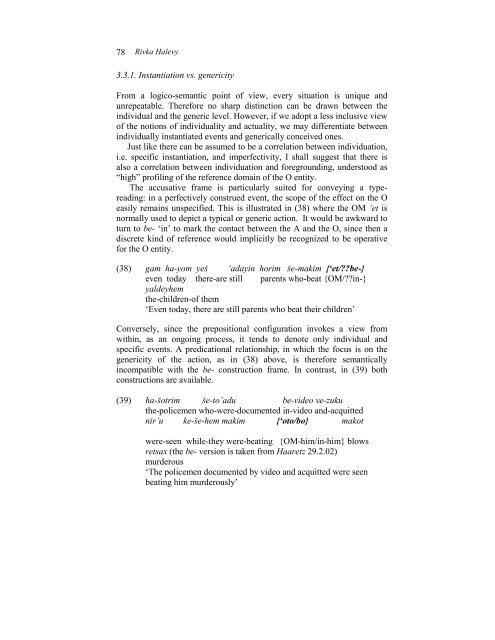
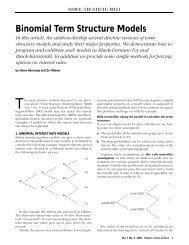
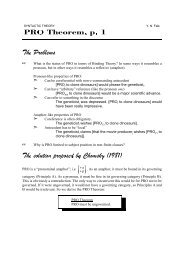
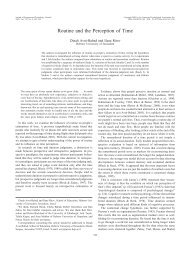
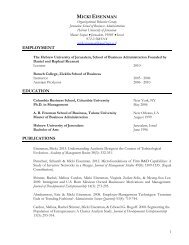
![CV [PDF] - Pluto Huji Ac Il](https://img.yumpu.com/18174585/1/190x245/cv-pdf-pluto-huji-ac-il.jpg?quality=85)

